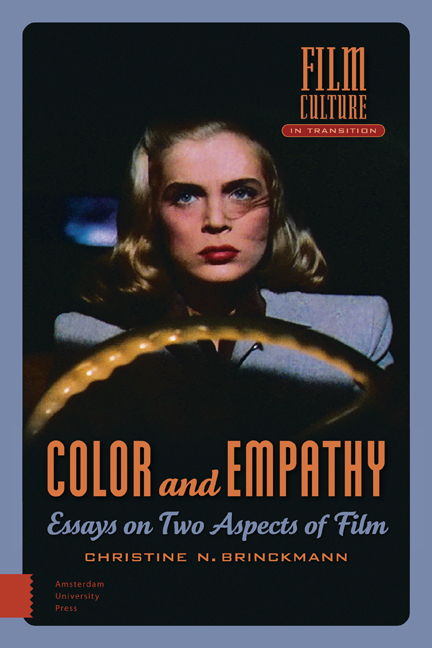Book contents
- Frontmatter
- Contents
- Preface
- Dedication
- Cinematic Color as Likeness and as Artifact: [2001]
- Chords of Color: [2006]
- The Tension of Colors in Colorized Silent Films: [2001]
- Structural Film, Structuring Color: Jenny Okun's Still Life: [1995]
- Desert Fury: A Film Noir in Color: [2012]
- The Work of the Camera: BEAU TRAVAIL: [2005]
- Empathy with the Animal: [1997]
- Motor Mimicry in Hitchcock: [1999]
- Abstraction and Empathy in the Early German Avant-garde: [1997]
- The Role of Empathy in Documentary Film: A Case Study: [2005]
- Genre Conflict in Tracey Emin’s Top Spot: [2007]
- Viewer Empathy and Mosaic Structure in Frederick Wiseman’s PRIMATE: [2009]
- CASTA DIVA: An Empathetic Reading: [2008]
- Publication Data
- Index of Films
- Index of Subjects
- Film Culture in Transition
The Tension of Colors in Colorized Silent Films: [2001]
Published online by Cambridge University Press: 23 June 2021
- Frontmatter
- Contents
- Preface
- Dedication
- Cinematic Color as Likeness and as Artifact: [2001]
- Chords of Color: [2006]
- The Tension of Colors in Colorized Silent Films: [2001]
- Structural Film, Structuring Color: Jenny Okun's Still Life: [1995]
- Desert Fury: A Film Noir in Color: [2012]
- The Work of the Camera: BEAU TRAVAIL: [2005]
- Empathy with the Animal: [1997]
- Motor Mimicry in Hitchcock: [1999]
- Abstraction and Empathy in the Early German Avant-garde: [1997]
- The Role of Empathy in Documentary Film: A Case Study: [2005]
- Genre Conflict in Tracey Emin’s Top Spot: [2007]
- Viewer Empathy and Mosaic Structure in Frederick Wiseman’s PRIMATE: [2009]
- CASTA DIVA: An Empathetic Reading: [2008]
- Publication Data
- Index of Films
- Index of Subjects
- Film Culture in Transition
Summary
[A] thorough treatment of colour in cinema in any era would need to analyse the delicate pas de deux orchestrated between realistic motives and metaphorical or spectacular effects.
– Tom GunningWhen I was a little girl I loved coloring books, especially those with lots of human or animal figures, and I imagined that they waited fervently to be animated with color. They positively cried out for it, so that great haste was called for in coloring them and rescuing them from their plight. Completeness was the motto, but living creatures naturally had priority and came first; the objects followed, and finally the background, the earth, and the sky. This memory often comes alive when I see partially colored films. I intuitively feel sorry for the figures who were not blessed with color and ask myself what made them so unattractive that they were neglected and left black-and-white.
These childlike thoughts do not occur to me with monochromatic tinting and toning, since these processes are not selective but affect the entire image systematically, according to the relative density of the black-and-white. In the transparent areas of the frame, certain objects or zones will stand out – as pure white in the case of toning, as clear color in a tinted film; and dark areas will register as black or nearly black in either method. Yet overall a democratic principle seems to reign. In the case of polychromatic coloring with brush or stencil, however, there often seems to be a random form of privileging at work, assigning certain colors to certain objects and thus attracting attention to them. This renders an arbitrary quality to the images, an off-hand sensuality, so to speak.
All the aforementioned possibilities for applying color – which are also found in combination – are distinguished by a certain artificiality, since their colors are not photographic. They are added to films that were previously completed without color (and were also screened in black-and-white versions). Yet colorization by brush or stencil represents a more striking intervention in the image than toning and tinting. On the one hand, it seems to offer more possibilities to imitate natural appearances, since it provides individual objects with local color. On the other, the number of hues applied is rather limited for practical reasons.
- Type
- Chapter
- Information
- Color and EmpathyEssays on Two Aspects of Film, pp. 61 - 74Publisher: Amsterdam University PressPrint publication year: 2014



